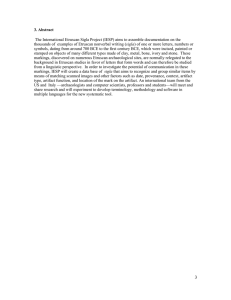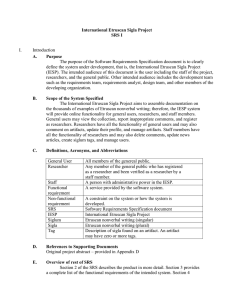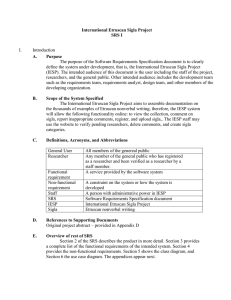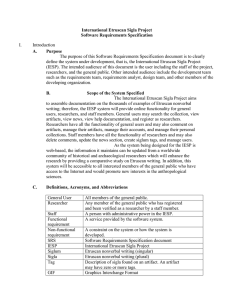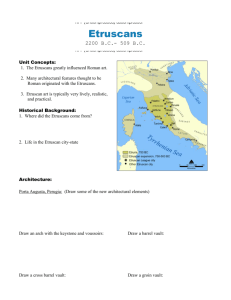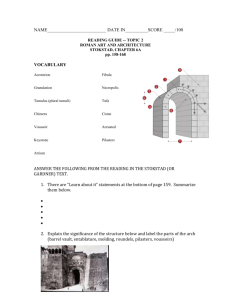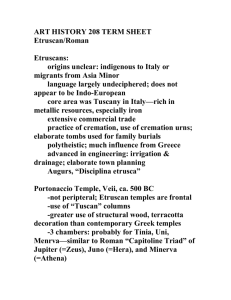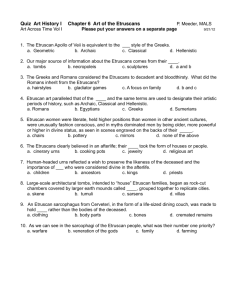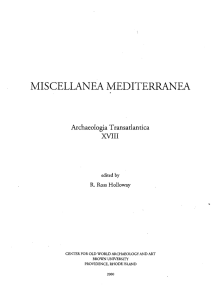4.1. Enhancing the Humanities through Innovation.
advertisement
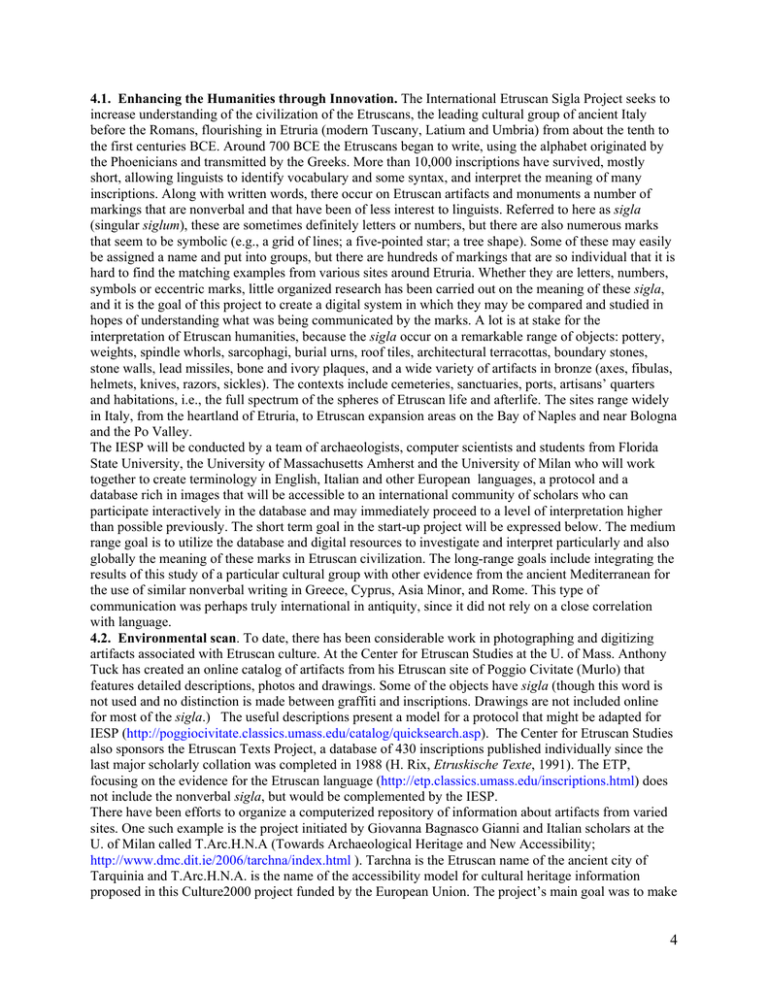
4.1. Enhancing the Humanities through Innovation. The International Etruscan Sigla Project seeks to increase understanding of the civilization of the Etruscans, the leading cultural group of ancient Italy before the Romans, flourishing in Etruria (modern Tuscany, Latium and Umbria) from about the tenth to the first centuries BCE. Around 700 BCE the Etruscans began to write, using the alphabet originated by the Phoenicians and transmitted by the Greeks. More than 10,000 inscriptions have survived, mostly short, allowing linguists to identify vocabulary and some syntax, and interpret the meaning of many inscriptions. Along with written words, there occur on Etruscan artifacts and monuments a number of markings that are nonverbal and that have been of less interest to linguists. Referred to here as sigla (singular siglum), these are sometimes definitely letters or numbers, but there are also numerous marks that seem to be symbolic (e.g., a grid of lines; a five-pointed star; a tree shape). Some of these may easily be assigned a name and put into groups, but there are hundreds of markings that are so individual that it is hard to find the matching examples from various sites around Etruria. Whether they are letters, numbers, symbols or eccentric marks, little organized research has been carried out on the meaning of these sigla, and it is the goal of this project to create a digital system in which they may be compared and studied in hopes of understanding what was being communicated by the marks. A lot is at stake for the interpretation of Etruscan humanities, because the sigla occur on a remarkable range of objects: pottery, weights, spindle whorls, sarcophagi, burial urns, roof tiles, architectural terracottas, boundary stones, stone walls, lead missiles, bone and ivory plaques, and a wide variety of artifacts in bronze (axes, fibulas, helmets, knives, razors, sickles). The contexts include cemeteries, sanctuaries, ports, artisans’ quarters and habitations, i.e., the full spectrum of the spheres of Etruscan life and afterlife. The sites range widely in Italy, from the heartland of Etruria, to Etruscan expansion areas on the Bay of Naples and near Bologna and the Po Valley. The IESP will be conducted by a team of archaeologists, computer scientists and students from Florida State University, the University of Massachusetts Amherst and the University of Milan who will work together to create terminology in English, Italian and other European languages, a protocol and a database rich in images that will be accessible to an international community of scholars who can participate interactively in the database and may immediately proceed to a level of interpretation higher than possible previously. The short term goal in the start-up project will be expressed below. The medium range goal is to utilize the database and digital resources to investigate and interpret particularly and also globally the meaning of these marks in Etruscan civilization. The long-range goals include integrating the results of this study of a particular cultural group with other evidence from the ancient Mediterranean for the use of similar nonverbal writing in Greece, Cyprus, Asia Minor, and Rome. This type of communication was perhaps truly international in antiquity, since it did not rely on a close correlation with language. 4.2. Environmental scan. To date, there has been considerable work in photographing and digitizing artifacts associated with Etruscan culture. At the Center for Etruscan Studies at the U. of Mass. Anthony Tuck has created an online catalog of artifacts from his Etruscan site of Poggio Civitate (Murlo) that features detailed descriptions, photos and drawings. Some of the objects have sigla (though this word is not used and no distinction is made between graffiti and inscriptions. Drawings are not included online for most of the sigla.) The useful descriptions present a model for a protocol that might be adapted for IESP (http://poggiocivitate.classics.umass.edu/catalog/quicksearch.asp). The Center for Etruscan Studies also sponsors the Etruscan Texts Project, a database of 430 inscriptions published individually since the last major scholarly collation was completed in 1988 (H. Rix, Etruskische Texte, 1991). The ETP, focusing on the evidence for the Etruscan language (http://etp.classics.umass.edu/inscriptions.html) does not include the nonverbal sigla, but would be complemented by the IESP. There have been efforts to organize a computerized repository of information about artifacts from varied sites. One such example is the project initiated by Giovanna Bagnasco Gianni and Italian scholars at the U. of Milan called T.Arc.H.N.A (Towards Archaeological Heritage and New Accessibility; http://www.dmc.dit.ie/2006/tarchna/index.html ). Tarchna is the Etruscan name of the ancient city of Tarquinia and T.Arc.H.N.A. is the name of the accessibility model for cultural heritage information proposed in this Culture2000 project funded by the European Union. The project’s main goal was to make 4 the artifacts, research findings, documents, and other items available to the public. This is difficult, however, because many of the items are dispersed throughout the world in various collections, museums, and archaeological sites. To attempt to resolve this problem, the idea of a “virtual museum” was envisioned, a cultural repository primarily using web-based hypertext as the main method of data storage. The resulting system is called the T-System. An illustration (Fig. 1) taken from a presentation by Piero Mussio from the University of Milan on Meta Data shows the concept behind the T-System and the virtual museum. So far the T-System has not been used for inscriptions or sigla and thus some completely new features must be devised to correlate the markings with the objects and even more importantly with each other. Another problem relates to the lack of consistency in excavation reports. The Etruscan Sigla Project will initially focus on objects from designated excavations under the supervision of the participating universities that can be described consistently in a protocol that includes standardized measurements, provenance, site type, artifact or monument type, physical data about the object such as mineral content, color, texture, etc., location of siglum on the artifact, method of marking, and date, as well as appropriate scanned drawings and photos. Etruscan objects from excavations by the U. of Milan at Tarquinia, by Florida State University at Cetamura del Chianti, and by the University of Massachusetts at Poggio Civitate (Murlo), fully accessible to the proposed teams from Italy and the US, will be used in a pilot study for the core of the the start-up program. 4.3. History and Duration of the Project. Research by Nancy de Grummond on sigla began when she became director of FSU excavations at Cetamura del Chianti, where more than 100 examples have been discovered. She directed the publication of some 76 of these by doctoral student Michael Robertson, in Studi Etruschi, 1989. Her research continued with an undergraduate research group organized by de Grummond at FSU in 1998-2000. The result was the assembling of references to hundreds of sigla in publications on the Etruscans, from the Rivista di Epigrafia Etrusca in the annual Studi Etruschi, from the Corpus of Etruscan inscriptions (Corpus Inscriptionum Etruscarum), from excavation reports in the annual Notizie degli Scavi and from numerous exhibition catalogs and other single publications on Etruscan archaeology. From these, some 436 of the best documented specimens were selected for insertion in a database (Microsoft Access, 2000). Using the database, de Grummond, Ceil Bare and Amy Meilleur, produced an article “Etruscan Sigla (‘Graffiti’): Prolegoma and Some Case Studies” (2000; see Figs. 2-4 attached) in which they described in detail the history of the study (and neglect) of sigla and proposed a protocol for excavators who may discover such evidence. The FSU team emphasized sigla that were easily recognizable as numbers or letters. Recently Giovanna Bagnasco Gianni of the U. of Milan has analyzed markings that seem to convey wider and complex meanings in a synthetic way, by targeting characters similar to the alphabetic ones, but used in combination with some other marking or having a particular scheme for a layout on the object (cf. Figs. 5-7, attached). Working with graduate assistants Alessandra Gobbi and Nicola Scoccimarro, she has built up a database containing recurrent associations between sigla and their layout, and has noted the type of artifact, the location of the siglum on the object, archaeological context (funerary, sanctuary, habitation), date, and location. So far the team has identified a corpus with 17 basic categories of signs, which can be related to geography, chronology, site type, and function of these non-literary markings. The most recent results of the Milan team will appear in an article “Segni eloquenti in necropoli e abitato,” in L’écriture et l’espace de la mor, Rencontres internationales, Rome, 2009, in press. This fruitful approach will be pursued and it is hoped that the methodology can be successfully transferred into the project of the IESP. Bagnasco Gianni’s commitment to digital humanities was displayed in the conference she organized at Milan in 2007 with funding from the European Union, “Bridging Archaeological and Information Technology Culture for Community Accessibility.” The papers have now appeared as a volume by this name in the Tarchna series, 2008. Her collaborator Stefano Valtolina of the Dept. of Computer Science and Communication at the U. of Milan will continue to be involved in the initiatives to bridge archaeology and IT. Other than the funding from the EU, resources of university departments have been used providing computers, workspace, graduate assistantships and modest travel grants. It is anticipated that funding in the future will be requested from the NEH Digital Humanities Grants, Level II, as well as from sources 5 within the participating universities and from organizations that supported the creation of the Etruscan Texts Project at the U. of Mass.: the American Philosophical Society, the Whiting Foundation, the Gladys Krieble Delmas Foundation, the Etruscan Foundation. After the start-up the project will require approximately three years to create the full database. Websites at the participating universities will insure the continuity of the project and the addition of newly discovered sigla in the future. 4.4. Work plan. Fall, 2009: At FSU a team of professors and students from the Depts. of Classics and Computer Science is already at work on the IESP, meeting weekly. Preliminary website established: http://classics.fsu.edu/IESP. The Dept. of Computer Science at FSU allows seniors from the team, enrolled in the Software Engineering classes, to participate in the development of a Requirements and Specification document in the IEEE format, a “straw man” needed to communicate thoughts and ideas to the community in establishing common requirements and agreed upon standards of data storage, retrieval, and communication. Investigation is underway on the current state of research in the area of digitizing Etruscan artifacts, including the biodiversity information system in the Darwin Corps Standard. Spring, 2010: Time of grant award (March). Scheduling of meetings to make presentations and exchange ideas with colleagues and students at U. of Mass. (spring) and U. of Milan (summer). After receiving feedback, the team will develop a prototype whose main purpose will be to verify the requirements and to develop a more detailed design of an actual system. Fall, 2010: Preparation of texts and images of sigla as appropriate for the protocol, by de Grummond and assistants in consultation with site directors Tuck and Bagnasco Gianni. Insertion of materials in pilot site. Delivery of papers on interim progress at national and international meetings. Spring, 2011: Completion of requirements document with specifications and a preliminary design plan and proposal for follow-up work. 4.5. Staff. Nancy de Grummond - PI. Oversees project strategy, organizational paperwork and grant applications. Arranges meetings of the participants. Coordinates research on the siglaat Cetamura and other sites. Will utilize assigned research time at FSU during the grant period (25%). David Gaitros - Co-PI. Coordinates instruction in computer activities, researches comparative systems and constructs database. Will utilize assigned research time at FSU (10%). Alexander Segers - student assistant in gathering material on publication of sigla. Megan Murphy - student assistant in developing and maintaining a website for IESP. Giovanna Bagnasco Gianni - coordinates sustained program of research on Etruscan sigla at Tarquinia and other sites and creates liaison with computer science experts at the University of Milan. Provides texts and images of sigla from Tarquinia for database. Stefano Valtolina - collaborates with Bagnasco Gianni in new IT issues and creating appropriate technology for the T.Arc.H.N.A. system for images that will be produced by FSU. Alessandra Gobbi and Nicola Scoccimarro - continue Milan database work. Will collaborate with American students to teach them about how the Milan project has functioned. Rex Wallace - consults on database of the Etruscan Texts Project. Anthony Tuck - consults on archaeological databases; provides texts and images of sigla from Poggio Civitate (Murlo). 4.6. Final Product and Dissemination. Out of this grant will come a series of prototypes (both functioning and non-functioning) that will articulate to the community the vision of the system that will satisfy the requirements. The resulting system will incorporate the use of computing platforms that are widely accepted among the IT community using standard operating systems (Linux, Ubuntu, etc), free database systems ( example: MySQL), and development environments and languages used around the world such as PHP, Java, and Javascript. The final product is visualized as a database and website that are interactive, available from a US site and from a website in Italy. In the US, the Center for Etruscan Studies at U. of Mass. has offered to host and maintain the site, and this seems the most appropriate location. The FSU site will be maintained as a source of information and communications (http://classics.fsu.edu/IESP). 6
